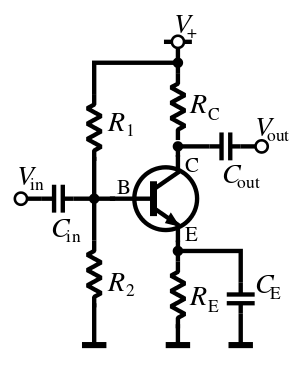Semiconductor devices: Transistors (2) – Applications

Amplifying Voltage
If we place a large resistor in a circuit containing a transistor we can amplify the incoming voltage, since according to Ohm’s law voltage is equal to current times resistance. So a current crossing a small resistance corresponds to a small voltage. But if the same current is made to cross a much larger resistance, it will yield a much larger voltage, that is, the small input voltage will be amplified to yield a large output voltage.
For example, the amplified voltage can correspond to a portion of a digital sound wave, in which the analog wave has been approximated by a series of single voltages. This small portion of the wave (one bit) can be represented by a tiny voltage received at the transistor base from a photocell that is stimulated by a laser beam that picked up the signal from a music compact disc (CD). The amplified voltage from the transistor can then be sent to a speaker set, which turns the signal into a vibration that is emitted by the speakers as a pressure wave that your ears detect and your brain interprets as—let’s say—the beautiful voice of Adele singing “Hello”.

Random Access Memory
As a logic device, a transistor can act like a diode in allowing current to pass or in preventing current flow, depending upon the voltage at the base. By combining p-n-p and n-p-n transistors together, along with diodes, various logic systems and “gates” can be created. One of the most useful applications of this is in the creation of “dynamic random access memory” (DRAM) in computers, devices that store data that can be accessed at will in random order.
As is well known, information is stored digitally in computers, that is, it is stored in the form of strings of binary numbers made up of just 1s and 0s. Each binary number (whether it is 1 or 0) is called a“bit.” (Eight bits make a “byte.”) For instance, the binary number 10101010, which has eight bits (making one byte), is equivalent in the decimal system to the number 170. If you happen to type the number 170 onto a spread sheet and save it, the computer will first convert the decimal number 170 to the binary number 10101010. It will then assign each of the eight bits to a single cell within dynamic random access memory. Each bit will correspond to the charge on a charge device known as a capacitor, which, in principle, is just two plates held next to each other. If the bit is 1, the capacitor will receive a small charge. If the number is 0, it receives no charge.
Now you ask the computer to retrieve the number 170 from memory. Here’s what happens. Your request is sent to the “word line” as a positive voltage, which is then applied to the base of the transistor in each circuit on that line. Since the base is now positive, the charge on the capacitor can flow through the transistor and up through the “bit line” to the processor which detects the current and identifies the number in that cell as a 1. Of course, if there is no charge stored in the capacitor to begin with, there will be no current on the bit line, and that bit will be identified as 0.
Many personal computers today now come with hundreds of gigabytes of memory, miniaturized on microprocessor memory modules. It is astonishing how far this technology has come in only a few decades since the invention of the transistor in 1947. Where will we be in another 50, or even another 10 years?
Author: César Tomé López is a science writer and the editor of Mapping Ignorance